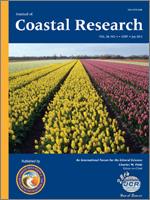O'Connell, M.J.; Shugart, H.H., and Okin, G.S., 2012. Measurement and monitoring of barrier island forest sensitivity to ecohydrological change using LIDAR remote sensing.
Both sea-level rise and the attendant changes in wave overwash events can greatly modify or destroy coastal terrestrial ecosystems; thus, it is essential to have a priori identification of particularly sensitive forests (and other ecosystems). This article reports an application of airborne LIDAR (light detection and ranging) to study vulnerable coastal forests—the important case of natural mid-Atlantic maritime pine forests. We investigate the Experimental Advanced Airborne Research LIDAR (EAARL) for its accuracy in making detailed forest structural measurements, producing inferential statistics for remote monitoring, and detecting changes in barrier island forest ecohydrology. Results show that EAARL can be deployed with high confidence in loblolly pine (Pinus taeda L) ecosystems for baseline biophysical descriptions. EAARL measurements predict plot-level volume, height indices, and basal area with coefficients of determination ranging from 0.72 to 0.95. EAARL data also provide one-dimensional vertical metrics: maximum canopy height, height of peak canopy density, and bare earth elevation at standard errors of 1.8, 1.3, and 0.3 m, respectively.
LIDAR-determined structural data are significantly correlated with environmental gradients on Assateague Island, thus providing an important reference state for continued ecological study. EAARL data model the plant area index (PAI) at an r2 of 0.73 over the study area. Soil-water availability is estimated using the depth to water table, and a soil texture index is correlated with PAI at rs = 0.54, p = 0.004. This basic ecohydrological relationship is monitored in a conceptual model predicting the structural changes expected with rising water over landscapes. The model predicts forest structural decline for most of the study area with incrementally higher sea surfaces. It is expected that the methods and theories developed here can be adapted to the LIDAR-based monitoring of similar habitats.





